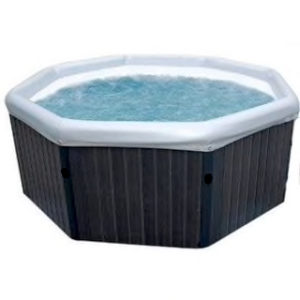Doctors’ Notes
BackHot Tub Safety
I had always wanted a hot tub, so recently my family “splurged” and we got one. I envisioned spending many summer nights with my family — which includes my 6-year-old, 4-year old, and 2-year-old — soaking in the hot tub. But after reading about the safety of hot tubs and children, I wanted, as both a parent and a pediatrician, to make sure other parents were aware of the additional hazards a hot tub can pose for children, and of how to make your hot tub experience with your children a safe one.

 Accidents
Accidents
According to the Consumer Product Safety Commission (CPSC), drowning is the main hazard associated with hot tubs and spas. About one-fifth of those deaths were drownings of children under the age of five. The CPSC states that spas and hot tubs should be covered with a locked safety cover when not in use, and children should be kept away unless there is constant adult supervision.
Since 1990, the CPSC reports of 43 incidents (including 12 deaths) in which people’s hair was sucked into the suction fitting of a spa, hot tub, or whirlpool, causing the person’s head to be held under water. The child’s hair gets entangled in a drain cover as the water and hair are drawn through the drain. Children may play a “hold your breath the longest” game, which permits long hair to be sucked into the drain. The CPSC has developed a voluntary standard for drain covers that helps reduce the risk of hair entanglement, and advises consumers to make sure they have drain covers that meet this standard. The bottom line: no one should submerge their head underwater in a hot tub. If the drain cover is missing or damaged, shut down the hot tub or spa until the cover is replaced.
Temperature
Consider your hot tub temperature. The CPSC has documented several deaths as the result of extremely hot water (approximately 110°F). High temperatures can cause drowsiness, which can lead to unconsciousness and result in drowning. Additionally, increased body temperatures can lead to heat stroke and possible death. Currently, there are established required temperature controls that help make sure hot tub and spa water temperatures never exceed 104°F.
Infants & Toddlers
The Association of Pool & Spa Professionals (APSP) notes that infants should not be permitted in a hot tub at all, since a their thin skin makes them more susceptible to overheating. The APSP also recommends that toddlers and other young children should not be allowed in a hot tub unless they can stand on the bottom and have their heads completely out of the water. Also, since little ones have very little control over bodily functions, spas can become unsanitary almost instantly when “accidents” happen.
When children are tall enough, they should not use a hot tub for more than five minutes at a time, especially at the maximum temperature of 104°F. Even then, young children should avoid full body immersion and should instead use the “jump seats” on the side that permit only waist-high immersion. You can dropping the spa temperature to 98 degrees allow for longer soaks — but never more than 15 minutes at a time.
CPSC Recommendations
The CPSC recommends following these safety precautions when using a hot tub, spa, or whirlpool:
• Have a professional check your spa or hot tub and make certain it’s in safe operating condition, with drain covers in place and not cracked or missing. Check drain covers yourself periodically throughout the year.
• Keep water temperatures at or below 104°F, and consider 98 degrees with children in the home.
• When the spa or hot tub is not in use, always use a locked safety cover.
• Keep young children away from hot tubs and spas unless there is constant adult supervision.
• Make certain the spa has dual drains and drain covers, as required by current safety standards.
• Make certain all users (including children) know the location of the cut-off switch for the pump so that it can be turned off quickly in the event of an emergency.
• Drink fresh water while soaking to prevent dehydration
OTHER SAFETY REMINDERS
• Like a pool, hot tubs and spas should be surrounded by a fence at least four feet high with a self-latching gate or door in the fence (to make the area inaccessible to children and unauthorized people) or an approved, lockable safety cover.
• Your own home isn’t the only place your child may encounter a hot tub or spa. Be aware of friends and family members your child may visit where a hot tub may also be present. And remember that hot tubs may be present during stays at hotel, motels, or resorts while traveling or on your family vacation.
• A well-chlorinated hot tub has little odor; a strong chemical smell indicates a maintenance problem. Pool and hot tub disinfectant test strips are available at local home improvement stores, discount retailers and pool supply stores. Consult with your family physician or healthcare provider regarding any health concerns regarding your family, and consult with a hot tub or spa professional regarding safety and maintenance issues.
FINAL THOUGHTS
Responsible adult supervision is key to child pool, hot tub safety and water safety. There should always be an adult designated to maintain constant visual contact with children whenever they are near, or could get near any body of water. Hot tubs, spas, and whirlpools are wonderful additions to the home and a special treat that allows you to pamper yourself a bit after a long, stressful day. By educating yourself on the potential dangers, practicing regular maintenance, and providing vigilant adult supervision in the presence of children, you’ll be able to enjoy a soothing, therapeutic soak in the hot tub with no additional worries!
Dr. Ditte Karlovits joined the practice in 2012.